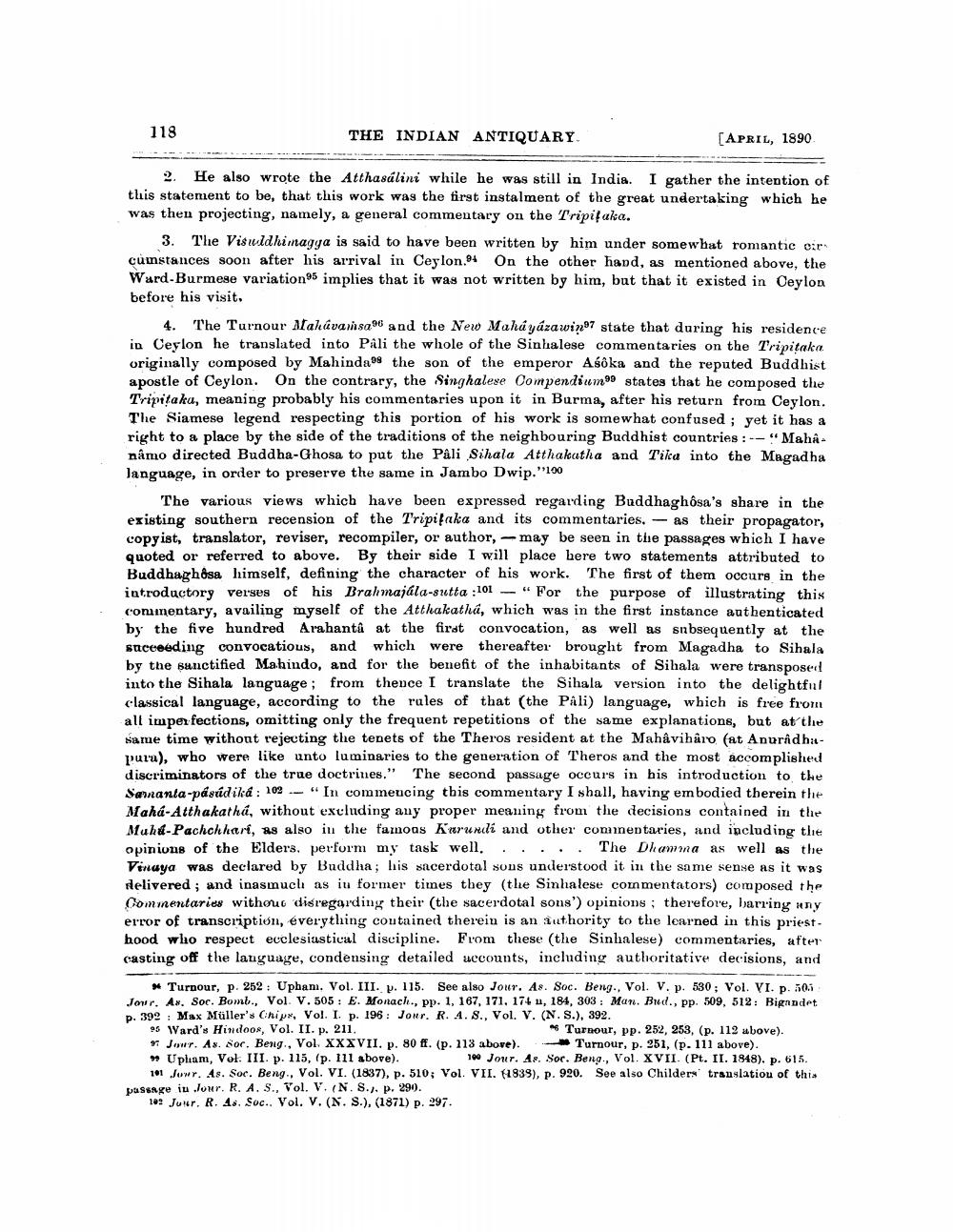________________
118
THE INDIAN ANTIQUARY
[APRIL, 1890
2. He also wrote the Atthasálini while he was still in India. I gather the intention of this statement to be, that this work was the first instalment of the great undertaking which he was then projecting, namely, a general commentary on the Tripitaka.
3. The Visuudhinagya is said to have been written by him under somewhat romantic oir cumstances soon after his arrival in Ceylon.84 On the other hand, as mentioned above, the Ward-Burmese variation implies that it was not written by him, but that it existed in Ceylon before his visit.
4. The Turnour Atahavarisao and the New Maháyázawin7 state that during his residence in Ceylon he translated into Pali the whole of the Sinhalese commentaries on the Tripitaka. originally composed by Mahinda 98 the son of the emperor Asoka and the reputed Buddhist apostle of Ceylon. On the contrary, the Singhalese Compendium80 states that he composed the Tripitaka, meaning probably his commentaries upon it in Burma, after his return from Ceylon. The Siamese legend respecting this portion of his work is somewhat confused; yet it has a right to a place by the side of the traditions of the neighbouring Buddhist countries :--"Mahanamo directed Buddha-Ghosa to put the Pâli Sihala Atthakatha and Tilca into the Magadha language, in order to preserve the same in Jambo Dwip."190
The various views which have been expressed regarding Buddhaghộsa's share in the existing southern recension of the Tripitaka and its commentaries, -as their propagator, copyist, translator, reviser, recompiler, or author, may be seen in the passages which I have quoted or referred to above. By their side I will place here two statements attributed to Buddhaghosa himself, defining the character of his work. The first of them occurs in the introductory verses of his Brahmajála-sutta :101 - " For the purpose of illustrating this commentary, availing myself of the Atthakatha, which was in the first instance authenticated by the five hundred Arahanta at the first convocation, as well as subsequently at the succeeding convocatious, and which were thereafter brought from Magadha to Sihala by the sanctified Mahindo, and for the benefit of the inhabitants of Sihala were transposed into the Sihala language; from thence I translate the Sihala version into the delightful classical language, according to the rules of that (the Pâli) language, which is free from all imperfections, omitting only the frequent repetitions of the same explanations, but at the same time without rejecting the tenets of the Theros resident at the Mahâviharo at Anuradhapuru), who were like unto luminaries to the generation of Theros and the most accomplished discriminators of the true doctrines." The second passage occurs in his introduction to the Sananta-pásúdiká : 102 - "In commencing this commentary I shall, having embodied therein the Mahá-Atthakatha, without excluding any proper meaning from the decisions contained in the Mahd-Pachchhart, as also in the famoas Kurundi and other comentaries, and including the opinions of the Elders, perform my task well... The Dhamma as well as the Vinaya was declared by Buddha; his sacerdotal sons understood it in the same sense as it was delivered ; and inasmuch as iu former times they (the Sinhalese commentators) composed the Cominentaries without disregarding their (the sacerdotal sons') opinions; therefore, barring any error of transcription, everything coutained therein is an authority to the learned in this priest. hood who respect ecclesiastical discipline. From these (the Sinhalese) commentaries, after casting off the language, condensing detailed accounts, including authoritative decisions, and
* Turnour, p. 252: Upham. Vol. III. p. 115. See also Jour. As. Soc. Beng., Vol. V. p. 530; Vol. VI. p. 501 Jour. Ax. Soc. Bomb., Vol. V. 505: E. Monach., pp. 1, 167, 171, 174 u, 184, 303: Man. Bud., pp. 509, 512: Bigandet p. 392 : Max Müller's Chips, Vol. I. p. 196: Jour. R. 4. 8., Vol. V. (N. S.), 392. 95 Ward's Hindoos, Vol. II. p. 211
^ Turnour, pp. 252, 253, (p. 112 above). Jowr. As. Sor. Beng., Vol. XXXVII. p. 80 ff. (p. 113 above). - Turnour, p. 251, (p. 111 above). Upham, Vol. III. p. 115, (p. 111 above).
100 Jour. As. Soc. Beng., Vol. XVII. (Pt. II. 1848), p. 615. 101 Juwr. As. Soc. Beng., Vol. VI. (1837), p. 510; Vol. VII. (1833), p. 920. See also Childers' translatiou of this passage in Jour. R.A.S., Vol. V. (N. S.). p. 290.
10. Juur. R. As. Soc., Vol. V. (N. S.), (1871) p. 297.




